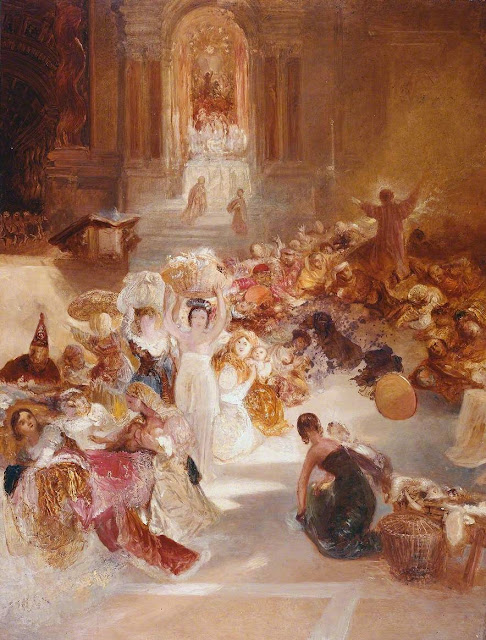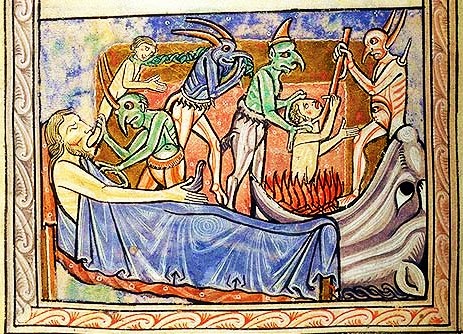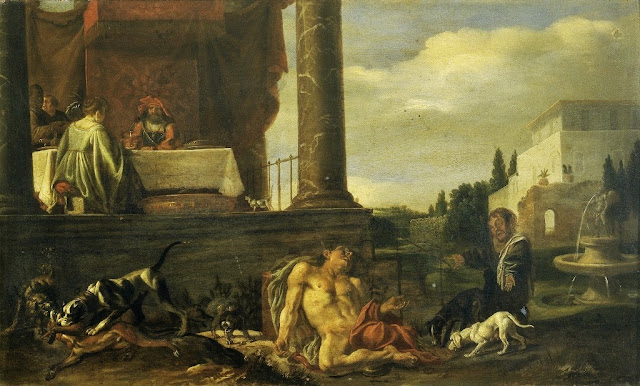 |
Fra Angelico, Annunciation
Italian, 1424-1426
Madrid, Museo Nacional del Prado |
“The angel Gabriel was sent from God
to a town of Galilee called Nazareth,
to a virgin betrothed to a man named Joseph,
of the house of David,
and the virgin's name was Mary.
And coming to her, he said,
"Hail, full of grace! The Lord is with you."
But she was greatly troubled at what was said
and pondered what sort of greeting this might be.
Then the angel said to her,
"Do not be afraid, Mary,
for you have found favor with God.
Behold, you will conceive in your womb and bear a son,
and you shall name him Jesus.
He will be great and will be called Son of the Most High,
and the Lord God will give him the throne of David his father,
and he will rule over the house of Jacob forever,
and of his Kingdom there will be no end."
But Mary said to the angel,
"How can this be,
since I have no relations with a man?"
And the angel said to her in reply,
"The Holy Spirit will come upon you,
and the power of the Most High will overshadow you.
Therefore the child to be born
will be called holy, the Son of God.
Mary said, "Behold, I am the handmaid of the Lord.
May it be done to me according to your word."
Then the angel departed from her."
(Luke 1:26-35, 38)
Excerpts from Gospel for the Feast of the Annunciation
The Annunciation is one of those Gospel episodes that are really difficult to write about. The tale is simple in many ways, although it opens the door to a mystery that is beyond our comprehension. An angel comes to a young, completely inexperienced girl and tells her she has been specially favored by God and will be the mother of His son. The girl, very sensibly, asks how that can be as she has not had sexual relations with any man. The angel explains that the Holy Spirit will engender the child. The girl accepts the Divine Will. It is a story with only two visible characters: a girl and an angel (who is presumably visible since the girl can see him). There is no description of the location of the encounter and no other visible characters.
Because of the non-specificity of this encounter artists have been free to imagine it in all sorts of ways. They have created thousands and thousands of works of art in a bewildering array of styles and settings. There are, in fact, so many depictions of this scene that it is extremely difficult to choose examples to study. A query for “Annunciation” on the Metropolitan Museum of Art website yielded 274 works from their collection alone. A similar query to a larger art historical search engine yielded 6,316 examples. Many of these are minor examples, of course, but even among major works of art the number of Annunciations is huge. Yet all boil down to two major figures: a girl and an angel.
 |
Fra Angelico, Annunciation
Italian, 1424-1426
Madrid, Museo Nacional del Prado |
Consequently, I have decided that, instead of giving you many examples of various types of Annunciation images, I will focus
once more on just one. This is the transcendental lovely image by Fra Angelico in the collection of the
Prado Museum in Madrid. It was painted on panel sometime between 1424 and 1426, possibly for the church of San Lorenzo in Florence, possibly for the for the Dominican convent of St. Domenic in Fiesole, near Florence where it was historically placed.
1
The entire right hand side of the picture presents the actual Annunciation scene in a very traditional Italian manner. There we see Mary, seated on a bench draped in fabric which also drapes the wall behind her, forming a kind of cloth of state. She sits in an open, groin-vaulted loggia, an open prayer book on her knee, and responds gently to the approach of Gabriel, her gesture mirroring his. Gabriel appears to have just landed, his wings still half open, his knees just beginning to bend. He is dressed in a magnificently embroidered tunic, which from its soft folds appears to be made of fine silk. His wings, in shades of gold, are eyed, like the tail feathers of the peacock.
 |
| Detail of the hand of God the Father |
From the upper left corner of the picture, the hands of God send streams of golden light toward her and, on those beams, the Holy Spirit is seen as a dove descending (just above Gabriel's head).
 |
| Detail of center of the picture |
Above the column that divides Gabriel and Mary is an image of Jesus, presented as a bust in relief. Thus, all the Persons of the Trinity appear in some way within the picture. On Mary's side of the space, seated on the iron cross bar between the pillars, is a swallow, symbolic of the Incarnation.
2
 |
Detail of left side of painting.
|
The entire left side of the painting is occupied by a garden filled with highly detailed representations of plant life. And, in this garden appears the scene from Genesis in which Adam and Eve are being driven out of the Garden of Eden by an angel. This angel bears a striking resemblance to Gabriel himself. And Eve bears a resemblance to Mary.
We see here the tipping point of salvation history. Mary is being invited to participate in righting the wrong done by Adam and Eve. Her obedient "fiat" (Be it done to me) will cancel their disobedience in eating the forbidden fruit.
The equation between Mary and Eve is an old one in Christian thought. Already in the 2nd century
Irenaeus, bishop of Lugdunum in Roman Gaul (modern Lyons, France) had written in his treatise
Against Heretics “thus also it was that the knot of Eve's disobedience was loosed by the obedience of Mary. For what the virgin Eve had bound fast through unbelief, this did the virgin Mary set free through faith.”3
This equation of Mary and Eve derives from the New Testament equation of Christ with Adam made by St. Paul who, in his great reflection on the Resurrection in
Corinthians I, states
“For since death came through a human being, the resurrection of the dead came also through a human being. For just as in Adam all die, so too in Christ shall all be brought to life…” (I Corinthians 15:21-22).
This equation between Jesus and Adam and between Mary and Eve was a familiar one in medieval art. For example, in the Klosterneuburg Altarpiece by Nicholas of Verdun, one of the greatest works of 12th century art, the plaques that illustrate Biblical events are arranged in three rows: scenes before the Law of Moses on the top, scenes of the Old Testament after the Law of Moses on the bottom, and related scenes from the New Testament in the middle.
Thus, the plaque of the Annunciation is placed between the annunciation to Abraham of the birth of Isaac (top) and the annunciation of the birth of Samson to Samson’s previously barren mother (bottom).
4 All of these annunciations have about them an element of the miraculous, but only the Annunciation to Mary will result in the birth of the Son of God.
 |
Nicholas of Verdun, Annunciation of the Birth of Isaac
Top Row - Events Before the Law
Mosan School, 1181
Klosterneuburg Abbey, Austria
|
 |
Nicholas of Verdun, Annunciation of the Birth of Jesus
Middle Row - Events Under Grace
Mosan School, 1181
Klosterneuburg Abbey, Austria
|
 |
Nicholas of Verdun, Annunciation of the Birth of Samson
Bottom Row - Events Under the Law
Mosan School, 1181
Klosterneuburg Abbey, Austria
|
In the
Biblia Pauperum produced in the late 15th century by the Rambures Master, now in the Meermano Museum at the Hague, the Annunciation is placed between the Temptation of Eve, in which the half-human, half-reptile tempter approaches Eve and the annunciation of a sign from heaven by an angel to Gideon. The sign given to Gideon is that dew had formed only on a fleece, not on the underlying ground. This miraculous dewfall is itself a type of the Virgin Birth, which Gabriel is about to announce.
 |
Rambures Master, Temptation of Eve, Annunciation, Sign for Gideon
from Biblia pauperum
Hesdin or Amiens, ca. 1470
The Hague, Meermano Museum
MS MMW 10 A 15, fol. 21r |
What Fra Angelico is showing us in the Prado altarpiece is the moment just before the world begins anew. Gabriel has not yet announced his mission. When he does, Mary's yes will begin the new creation, with Jesus as the new Adam and Mary herself as the new Eve in a new Garden of Eden of the spirit.
For more on the iconography of the Annunciation see the following links:
- The Annunciation, Part I, Simplicity
- The Annunciation, Part II – Enter A Dove
- The Annunciation, Part III – In the Garden
- The Annunciation, Part IV: "As If She Were A Dove That Dwelt There"
- The Annunciation, Part V: Telling The Whole Story
- The Annunciation, Part VI: The Annunciation Witnessed
- The Annunciation, Part VII, In the House
- The Annunciation, Part VIII, In the Bedroom
© M. Duffy, 2012, updated 2017
_______________________________
1. Kanter, Laurence. "Fra Angelico: A Decade of Transition (1422-32)" in
Fra Angelico, New York, New Haven and London, The Metropolitan Museum of Art and Yale University Press, 2005, pp. 80-83. This is the catalogue of an exhibition of the work of
Fra Angelico held at the Metropolitan Museum of Art in New York, October 26, 2005 - January 29, 2006.
2. Ferguson, George.
Signs and Symbols in Christian Art, New York, Oxford University Press, 1966, pp. 25-26.
3. Irenaeus of Lyons,
Against Heresies (
Adversus haereses), Book III, Chapter 22, Section 4. Translated by Alexander Roberts and William Rambaut. From
Ante-Nicene Fathers, Vol. 1. Edited by Alexander Roberts, James Donaldson, and A. Cleveland Coxe. (Buffalo, NY: Christian Literature Publishing Co., 1885.) Revised and edited for New Advent by Kevin Knight. <
http://www.newadvent.org/fathers/0103322.htm>.
4. The arrangement of the plaques is detailed at
http://ftp.sunet.se/pub/etext/wiretap-classic-library/Latin/Malin/verdun.txt













,%20c.%201000_Munich,%20Bayerische%20Staatsbibliothek_MS%20Clm%204456,%20fol.%20119v.jpg)
,%20c.%201151-65_Schwartzrheindorf,%20Church%20of%20St.%20Clement.jpg)

_1st+q+13th+c__Arundel+157,+6v+det.jpg)



,%20c.%201420-1422_London,%20British%20Library_MS%20Royal%2020%20B%20IV,%20fol.%2082+2.jpg)
,%20c.%201493_Paris,%20BNF_MS%20VELINS%20906,%20fol.%2073r.jpg)
,%20c.%201495-1505_New%20York,%20Pierpont%20Morgan%20Library_MS%20H%205,%20fol.%2044v.jpg)


















,%20c.%201030_Nuremberg,%20Germanisches%20Nationalmuseum_MS%20Hs%20156142,%20fol.%2078r.jpg)



,%20Glencairn%20Museum.webp)







,%20c.%201487-1490_New%20York,%20Pierpont%20Morgan_MS%20M%20894,%20fol.%2094r.jpg)
_French%20(Tours),%20c.%201495-1505_New%20York,%20Pierpont%20Morgan%20Library_MS%20H%208,%20fol..jpg)


,%20c.%201325-50+London,%20British%20Library_MS%20Royal%2019%20C%20II,%20fol.%20100r.jpg)

,%20c.%201475-1485_New%20York,%20Pierpont%20Morgan%20Library_MS%20M%20130,%20fol.96r.jpg)
,%20c.%201475-1480_The%20Hague,%20Meermano%20Museum_MS%20RMMW%2010%20A%2011,%20fol.%2016v.jpg)
,%20c.%201495-1503_New%20York,%20Pierpont%20Morgan_Ms%20M%20261,%20fol.%2081v.jpg)
,%20c.%201500_Paris,%20BNF_MS%20Latin%20923,%20fol.%2069v.jpeg)
,%20c.%201510-1520_New%20York,%20Pierpont%20Morgan_MS%20M%20286,%20fol.%2071v.jpg)


,%20ca.%201190-1200_The%20Hague,%20Koninklijk%20Bibliotheek_MS%20KB%2076%20F%205,%20fol.16r%20(2).jpg)
,%2014th%20Century_Paris,%20BNF_MS%20Francais%20152,%20fol.%20413v.jpg)
,%20c.%201425=1450_Baltimore,%20The%20Walters%20Art%20Museum_MS%20W.174,%20fol.%20255r.jpg)
,%20c.%201475-1500_Paris,%20BNF_MS%20Francais%20178,%20fol.%2067r.jpg)
,%20c.%201320-1330_Paris,%20BNF_MS%20FRancais%20187,%20fol.%2017v.jpg)
,%20c.%201425-1450_Paris,%20BNF_MS%20Francais%20376,%20fol.%20113r.jpg)





,%20ca.%201190-1200_The%20%20Hague,%20Koninklijk%20Bibliotheek_MS%20KB%2076%20F%205,%20f%20(2).jpg)

,%20c.%201300-1310_Baltimore,%20The%20Walters%20Art%20Museum_MS%20W37,%20fol.%2030r.jpg)
,%20c.%201350_Paris,%20BNF_MS%20Francais%209561,%20fol.%20156v.jpeg)
,%20c.%201371-1372_The%20Hague,%20Meermano_MS%20RMMW%2010%20B%2023,%20fol504v.jpg)
,%20c.%201475-1480_The%20Hague,%20Meermano%20Museum_MS%20RMMW%2010%20A%2011,%20fol.%2016v.jpg)
,%20c.%201480-1500_New%20York,%20Pierpont%20Morgan_MS%20M%20179,%20fol.%20132r.jpg)
,%20c.%201495-1505_New%20York,%20Pierpont%20Morgan_MS%20M197_089v.jpg)
.jpg)
,%20c.%201500-1520_New%20York,%20Pierpont%20Morgan_MS%20M%20431,%20fol.%20115r.jpg)
,%20c.%201500_Paris,%20BNF_MS%20Latin%20923,%20fol.%2070r.jpeg)




_Flemish,%20c.%201521_Brussels,%20Musees%20Royaux%20des%20B-A.jpg)















,%20c.%201295_London,%20British%20Library_MS%20Additional%2054180,%20fol.%20188v.jpg)
